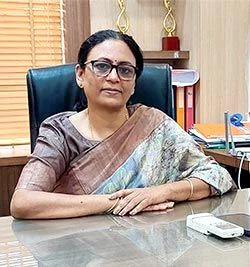Rinku Sarangi
Synonymous with school education, uniforms are used by school going children mostly to train the young towards adjusting to formal attire in later life, they help in ushering uniformity and harmony among students. Mostly mandated as social camouflages , uniforms are accepted as agents believed to help most pupils initiate their learning mode, build values, foster equity and equality, apart from fortifying a strong sense of community, helping learners to rise above class or other barriers and disparities in a severely iconoclastic society deeply divided by dogmas and prejudices.
Commonly an ensemble comprising of full shirts, trousers ,tunics or skirts ties, socks, belts, caps in summer and shoes of more than one type to suit different types of activities complemented with blazers in winter, school uniforms have been unequivocal signatures of student life . Once donned, they are believed to help in simplifying the process of identification of students especially in a crowd, besides preventing strangers or intruders with malefic intentions entering the safe precincts of the school amidst the school hours thus helping in keeping students safe .

While most schools in the US and Europe have been dismantling the age old system of students attending schools in uniforms, we in India still continue to use them.
A small yet a sect of detractors however express their views about the escalating costs of uniforms compounding the existing woes of parents, an argument that can’t be disregarded. The prevalent and customary use of unsuitable material and designs for making uniforms in a vast number of schools is another issue that swerves from tall claims about making children or users comfortable in them .
Complicated further by the long hours spent in school worsened further by the additional hours of commuting often in crowded vehicles especially in the hot and humid months , uniforms are certainly emerging as being compulsions among students and parents .
With school managements often coerced to compromise on comfort to cut upon escalating costs the limited choice of materials to suit budgets of parents often forces students to be at the receiving end.
Contradicting the theory of believers that uniforms enhance attendance and behaviour by merely donning them , statistics and evidence though limited also furnish proof that uniforms have not helped in better assimilation of knowledge or achievement of grades multiplying the growing numbers of dissenters.
With a rising sect of non conformists echoing that uniforms often erode the sense of identity in individuals besides slashing their creative spirits, a theory that seems to be gaining momentum , uniforms which were initially adopted to give credence to personal expression and freedom have now been seen as reasons inhibiting individuality especially in children trying to find or create their own self and individuality .

Uniforms should not be compulsions for at times it’s seen that uniformed school children often attract undue attention from criminals , especially affecting students of affluent schools leading to dangerous or even fatal consequences.
Recent reports of stray incidents involving rigidity or lack of flexible authorities who failure to accept or accommodate prevalent societal norms , religious faith and belief compel introspection in even believers . Certain gear in being either included or excluded as a part of our uniforms have led uniforms to be pivotal causes for provoking clashes and abating disturbances in the lives of carefree learners in a country deeply divided on religious beliefs and faiths.
While heritage schools meant for the socially affluent largely voting to keep their traditions and legacy alive through uniforms the rising voice dissent and rumblings among students in school corridors are no longer distant and cannot be relegated to the back burner in recent times.
School managements need to add fresh perspectives to their thoughts before choosing the materials considering the hot and humid climate in most parts of India especially the plains making it truly uncomfortable to have children to be in clothing not necessarily skin friendly and adding to their discomfort. Increased cases of skin infections in users is further complicated with most schools being non air conditioned . Wearing uniforms drenched in sweat for lengthy hours lead to health complications in children have come to the limelight in recent times . Further, compulsions for the school management to choose materials which do not run off colours or become dull with frequent washing to reduce costs and make it economical for parents also needs serious considerations. Decisions about designs and materials should be made after an all party mandate, and it would be good to have Government and school governance seriously looking into providing subsidised materials for uniforms and adding variety of breathable fabrics to choose from allowing comfort to be an essential criteria of uniforms.
Inclusion of ties in school uniforms often seen as relics of the past or better still a legacy of the Raj era forces one to think about its utility in a country with a weather mostly hot not to mention the horrifying summers compounding troubles for countless hapless youngsters coping with discomfort learning in cramped classroom strengths of strength of sixty if not more. While supporters argue that wearing ties add to the formal look helping build habit in children aiding them to easily adhere to dress codes in their professional lives later, with discomfort often disregarded not to forget several unnecessary discipline related cases arising in schools teachers and students on opposite sides . Giving up the tie in summers and included after the onset of the cooler weather can be an option that will help settle issues amicably.
Reiterating the same criteria for socks which need to be shorter and ideally made of absorbent material to add comfort for users who are in them for more than 8-10 of their school hours including travelling to and fro in them.
School management and authorities truly need to deliberate and introspect about current changes in learning and learners and study more about facts regarding uniforms and choose comfort over appearances. In a country flourishing with designers of immense calibre acknowledged for contributing wholesomely noted personalities and largely to the world even across shores with their creativity and innovation , schools should open their fora to create designs which are friendly, contemporary and economically affordable .

Further with most schools being restrictive in specifying hair styles across genders leading to senior learners often caught in a predicament of choosing fashion over rules generating unnecessary altercations with discipline and adherence leading in breeding reluctance in students to avoid schools and a building resentment against the school systems and teachers . With academic focus reigning supreme in the final school years, frequent and credible counselling must be practiced. Introduction of Friday or Saturday dressing in students may steer schools towards being places of choice for learners rather being institutes of compulsions.
A monthly or quarterly socialisation process allowing students to steer free from strict dress codes may be a road forward for schools and helping students break free from the rigour and confines often misconstrued as essential elements of schooling for youth in a country with the largest population of youth.
Building acceptance in the teaching community and school heads regarding changing norms and allowing them to comprehend learners in present day scenario which is vastly different from the cultures and backgrounds they hail from , may help make the entire learning community of teachers learners and parents nurture futures which are strong , free of bias and prejudice. Educating parents about changing societies and norms may help them to adapt better. The community also needs to respect our inherent culture and traditions alongside embracing change which need not necessarily clash but be accepting of diversities and diverse beliefs.
School and it’s identities are set with the uniforms often set precedents in cultures thus assuming importance of epic proportions in lives both in the near and distant future. School authorities and managements should build trust in the systems they create and head towards empowering the youth for the best as leaders and doers in the future they are custodians of.

Ms. Rinku Sarangi is an accomplished education professional with a diverse background spanning ICSE, CBSE, and IB schools. She’s a Fulbright scholarship recipient and has held leadership positions at prestigious institutions like SAI International School and KIIT International School in Bhubaneswar. Ms. Sarangi’s journey as the founding Principal of Mother Public School, Puri, has allowed her to pursue her educational vision and gain insight into contemporary educational needs. Her extensive travels to countries like Switzerland, France, Germany, Italy, Austria, Denmark, Thailand, and England have enriched her global perspective on education. Aside from her administrative roles, Ms. Sarangi is a respected columnist, contributing to various newspapers and magazines. Her passion for reading keeps her informed about the latest developments in various fields. Currently, she serves as the Principal of Adyant Higher Secondary School in Bhubaneswar, where she leads the institution toward educational excellence, nurturing the minds of future leaders.